Related Research Articles

According to the International Civil Aviation Organization (ICAO), a runway is a "defined rectangular area on a land aerodrome prepared for the landing and takeoff of aircraft". Runways may be a human-made surface or a natural surface. Runways, taxiways and ramps, are sometimes referred to as "tarmac", though very few runways are built using tarmac. Takeoff and landing areas defined on the surface of water for seaplanes are generally referred to as waterways. Runway lengths are now commonly given in meters worldwide, except in North America where feet are commonly used.

A heliport, sometimes referred to as a vertiport, are small airports which has a helipad, suitable for use by helicopters, powered lift, and various types of vertical lift aircraft.

Aviation safety is the study and practice of managing risks in aviation. This includes preventing aviation accidents and incidents through research, educating air travel personnel, passengers and the general public, as well as the design of aircraft and aviation infrastructure. The aviation industry is subject to significant regulation and oversight.

Blue Grass Airport is a public airport in Fayette County, Kentucky, United States, 6 miles west of downtown Lexington. Located among horse farms and situated directly across from Keeneland Race Course, Blue Grass Airport is the primary airport serving central and eastern Kentucky. More than 1.3 million passengers depart or arrive annually at Blue Grass Airport. In 2017, the airport served 1,316,847 passengers via four major airline carriers: Allegiant Air, American Airlines, Delta Air Lines, and United Airlines.

Aspen/Pitkin County Airport, also known as Sardy Field, is a county-owned public-use airport located three miles northwest of the central business district of Aspen, in Pitkin County, Colorado, United States. The airport covers an area of 573 acres (232 ha) at an elevation of 7,820 feet above mean sea level. It has one asphalt paved runway designated 15/33 which measures 8,006 by 100 feet.

Aircraft rescue and firefighting (ARFF) is a type of firefighting that involves the emergency response, mitigation, evacuation, and rescue of passengers and crew of aircraft involved in aviation accidents and incidents.
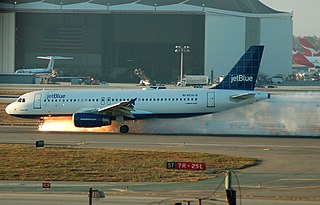
JetBlue Flight 292 was a scheduled flight from Bob Hope Airport in Burbank, California, to John F. Kennedy International Airport in New York City. On September 21, 2005, Captain Scott Burke executed an emergency landing in the Airbus A320-232 at Los Angeles International Airport after the nose gear jammed in an abnormal position. No one was injured.

In aviation, a water landing is, in the broadest sense, an aircraft landing on a body of water. Seaplanes, such as floatplanes and flying boats, land on water as a normal operation. Ditching is a controlled emergency landing on the water surface in an aircraft not designed for the purpose, a very rare occurrence. Controlled flight into the surface and uncontrolled flight ending in a body of water are generally not considered water landings or ditching, but are considered accidents. Most times, ditching ends up in aircraft structural failure.

An airport crash tender is a specialised fire engine designed for use in aircraft firefighting at aerodromes, airports, and military air bases.
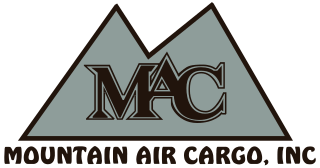
Mountain Air Cargo (MAC) is an American cargo airline based in Denver, North Carolina. It is a major contract carrier for FedEx Express, operating in the eastern United States and the Caribbean region. Previous turboprop operations in South America have been discontinued by FedEx, which now operates jet aircraft in that area. MAC is one of the largest feeder airlines in the United States. Its main maintenance facility is at Kinston Regional Jetport. All of the ATR, C408, and C208 aircraft operated by Mountain Air are owned by FedEx Express, and are operated by MAC on a "dry lease" basis.

A runway excursion is a runway safety incident in which an aircraft makes an inappropriate exit from the runway. This happens mainly due to late landings, or inappropriate runway choice.

A runway incursion is an aviation incident involving improper positioning of vehicles or people on any airport runway or its protected area. When an incursion involves an active runway being used by arriving or departing aircraft, the potential for a collision hazard or instrument landing system (ILS) interference can exist. At present, various runway safety technologies and processes are commonly employed to reduce the risk and potential consequences of such an event.
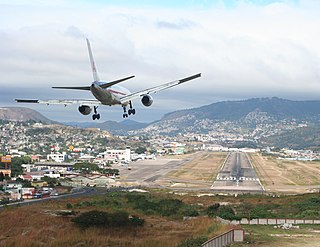
In aeronautics, the final approach is the last leg in an aircraft's approach to landing, when the aircraft is lined up with the runway and descending for landing. In aviation radio terminology, it is often shortened to "final".

A runway safety area (RSA) or runway end safety area is defined as "the surface surrounding the runway prepared or suitable for reducing the risk of damage to airplanes in the event of an undershoot, overshoot, or excursion from the runway."
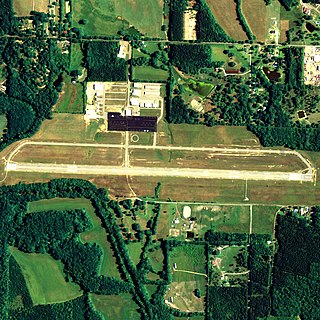
Walker County Airport, also known as Bevill Field, is a public airport located five miles (8 km) northwest of the central business district of Jasper, a city in Walker County, Alabama, United States. It is owned by the Walker County Commission.
The provision of rescue and firefighting services (RFFS) at all airports and aerodromes in the United Kingdom is a requirement under British law and under international agreements set out by the International Civil Aviation Organization.

China Airlines Flight 605 was a daily non-stop flight departing from Taipei, Taiwan at 6:30 a.m. and arriving in Hong Kong at 7:00 a.m. local time. On 4 November 1993, the aircraft went off the runway and overran attempting to land during a storm. It was the first hull loss of a Boeing 747-400.

Brunswick Executive Airport is a public use general aviation airport located 2 nmi (3.7 km) southeast of the central business district of Brunswick, a town in Cumberland County, Maine, United States. It is owned by the Midcoast Regional Redevelopment Authority.
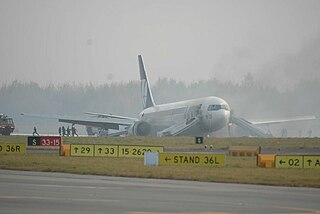
LOT Polish Airlines Flight 16 was a Boeing 767 passenger jet on a scheduled service from Newark, United States, to Warsaw, Poland, that on 1 November 2011 made a successful gear-up emergency landing at Warsaw Chopin Airport, after its landing gear failed to extend. All 231 aboard survived without serious injuries. A leak in one of the aircraft's hydraulic systems occurred shortly after takeoff, resulting in the loss of all of the hydraulic fluid supplying the primary landing gear system.

Pan Am Flight 799 was an international cargo flight from Los Angeles International Airport to Cam Ranh Airport in South Vietnam that crashed on December 26, 1968, near Anchorage, Alaska. The aircraft involved was a Boeing 707-321C aircraft operated by Pan American World Airways. All three crew members died in the crash.
References
- 1 2 3 4 "CertAlert No. 02-04: Aqueous Film Forming Foam (AFFF) Concentrations, Restrictions, and Other User Guidelines" (RTF), CertAlerts for Part 139 Airport Certification, Airport Safety and Operations Division, Federal Aviation Administration, 2002-07-11, retrieved 2023-12-10
- ↑ "How safe is firefighting foam?". FireRescue1. Retrieved 2022-03-25.
- ↑ "B763, Warsaw Poland, 2011 | SKYbrary Aviation Safety". skybrary.aero. Retrieved 2023-12-10.
- ↑ Accident investigation report: Pan American World Airways, Inc., Boeing 377, N 90943 in the Pacific Ocean, between Honolulu and San Francisco, October 16, 1956 (PDF), Civil Aeronautics Board, 1956-10-16, p. 5, retrieved 2023-12-10